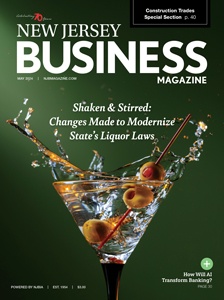
Environmental Realities and Regulations
The New Jersey Department of Environmental Protection (NJDEP) has adopted additional and more stringent rules/regulations in recent years, and the business community is at times struggling to navigate them.
By George N. Saliba, Contributing Writer On Mar 12, 2024Environmental engineers and their clients have been dealing with a bevy of NJDEP regulations ranging from floodwater and stormwater rules to new testing requirements for per- and poly-fluoroalkyl substances (PFAS), the widely publicized “forever chemical” contaminants found worldwide. When combined with a stringent 2023 New Jersey Environmental Justice Law (EJ) that aims to prevent harm to overburdened communities, some businesses and consultants find the overall scenario challenging.
It’s not just the NJDEP rules themselves which can create barriers to development. Several experts interviewed by New Jersey Business Magazine describe an NJDEP that has become more bureaucratic and that has been slow to issue permits despite a Licensed Site Remediation Professional (LSRP) program which was designed to offload more responsibilities to non-NJDEP experts and speed the remediation process.
Caryn Barnes, LSRP, PG, principal at Langan Engineering and Environmental Services, Inc., explains, “The LSRP program, which was designed to move cases faster to completion, has a growing bottleneck [concerning] NJDEP’s review and approval of Remedial Action Permits (RAPs). NJDEP approval is required before an LSRP can issue their closure documents (known as Response Action Outcomes). It can take months, or years, to gain NJDEP permit approvals.
“The NJDEP acknowledges this hurdle, and has invited the regulated community, consultants, and industry groups to collaborative stakeholder meetings to devise potential solutions,” Barnes continues. “Steps have already been taken, including training on submitting ‘approvable’ RAPs, and a roll out of an expedited review form to move ‘easier’ sites through the approval process. All parties acknowledge there is still work to do.”
Doug Neumann, director of environmental services at Dresdner Robin, offers similar sentiments: “As NJDEP creates more and more rules – again, LSRPs don’t issue permits, [they] prepare permit applications – we’re seeing a lot of delays. DEP doesn’t have [enough] staff to deal with the number of things that they’ve decided they want to do.”
Inland Flood Protection Rule / Coastal Area Facility Review Act (CAFRA)
Concerning NJDEP regulations, Kristopher Krzyston, northeast regional practice leader for environmental services at T&M Associates, comments: “It’s more regulations everywhere.” He cites, for example, the 2023 Inland Flood Protection Rule as well as the Coastal Area Facility Review Act (CAFRA). “In tidal areas, which are governed underneath the waterfront development policies, the waterfront development applications and rules have to be revised, which will [in turn] incorporate changes to the tidal, flood hazard areas,” he says. “So, [NJDEP] is covering the gamut.”
PFAS
The aforementioned per- and poly-fluoroalkyl substances (PFAS) are meanwhile creating “a huge amount of chaos, to a certain degree,” in the consulting world, according to Dresdner Robin’s Neumann. PFAS are chemicals used to make coatings and products resistant to heat, oil, stains, grease, and water, and have been found everywhere in the world. An overall investigation into PFAS has filtered from the U.S. Department of Environment Protection to the states – including New Jersey – which now requires that PFAS be included in site investigations.
Langan’s Barnes explains, “A handful of PFAS compounds are being regulated (although the NJDEP asks for the analysis of a broader suite of compounds) at much more stringent levels (parts per trillion), and the analytical methods are still evolving, adding uncertainty on defensibility. Additionally, there are no standards for every impacted media, and the remedial approaches don’t have a proven track record. Coupled with the pervasiveness of these compounds in the environment, it is no wonder that clients are hesitant to jump into investigating PFAS with no clear end in sight. The NJDEP is conducting a state-wide soil investigation to assess background concentrations in soil. What the data will be used for or how it will be applied is still being determined.”
Another reported issue is that laboratories often don’t yet have accreditation for PFAS testing, resulting in fewer labs where testing can be performed. Dresdner Robin’s Neumann says, “It’s great that the state says, ‘Hey, you should be undertaking an evaluation of these forever chemicals.’ Fine. Where are the labs that can run the samples? Now I have to send the samples out of state; the labs are behind in getting up to speed on being able to actually analyze the samples, and there’s very little technical guidance that has been released to the consultants. … We’re finding [PFAS] basically everywhere we look for [them].”
The Environmental Justice Law (EJ)
Also in play is New Jersey’s Environmental Justice Law (EJ), which became effective last year. According to the NJDEP, the law requires the agency “to evaluate environmental and public health impacts of certain facilities on overburdened communities (OBCs) when reviewing certain applications. New Jersey is the first state required to issue denials for new facilities that cannot avoid disproportionate impacts on OBCs or serve compelling public interest.”
Conclusion
Will environmental regulations hamper New Jersey’s competitiveness, especially since such rules often don’t exist in other nearby states?
T&M Associates’ Krzyston explains overall, “Before these [various] new rules [discussed in this article] were adopted, people were trying to get their applications in underneath the old rules, because they knew that when [the new rules] came, what was going to be 100 [residential units in a development] is now going to be 75: Your stormwater basins need to be bigger, and now the flood hazard area is closer to your property, and you could go through all of your design, go through the EJ process, and have it ruled as unfavorable.”
He concludes, “There’s huge impact potential [with the new rules and regulations], but what it comes down to in my mind is having a good, sound [environmental engineering] consultant who knows the policies and knows with whom to talk.”
To access more business news, visit NJB News Now.
Related Articles:





